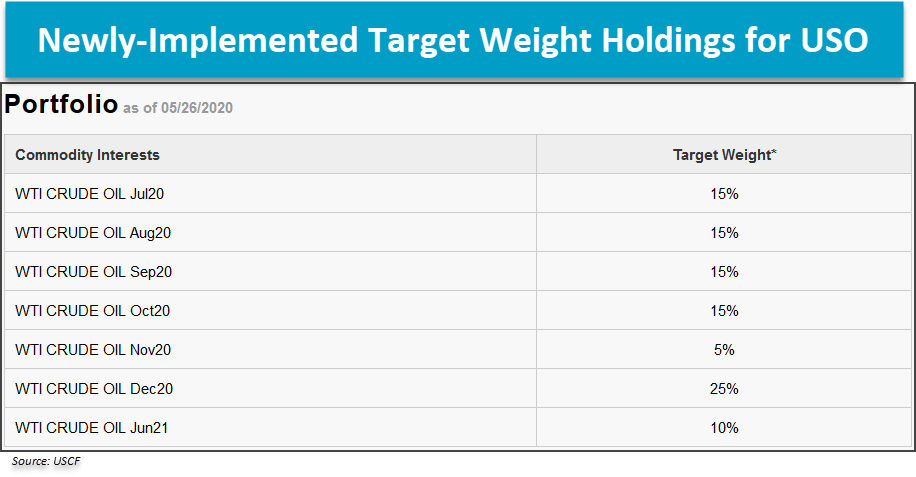
We discuss recent changes in the fund structure of the United States Oil Fund (USO).
Remember, these are technical comments only. Just as you must be aware of fundamental data for the stocks we recommend based on technical criteria in the report, so too must you be aware of important data regarding delivery, market moving government releases, and other factors that may influence commodity pricing. We try to limit our technical comments to the most actively traded contracts in advance of delivery, but some contracts trade actively right up to delivery while others taper off well in advance. Be sure you check your dates before trading these contracts. For questions regarding this section or additional coverage of commodities email james.west@dorseywright.com.
Data represented in the table below is through 05/26/2020:
Broad Market Commodities Report
Portfolio View - Commodity Indices
| Symbol | Name | Price | PnF Trend | RS Signal | RS Col. | 200 Day MA | Weekly Mom |
|---|---|---|---|---|---|---|---|
| CL/ | Crude Oil Continuous | 34.13 | Negative | Buy | X | 46.99 | +5W |
| DBLCIX | Deutsche Bank Liquid Commodities Index | 243.36 | Negative | Sell | O | 293.23 | +7W |
| DWACOMMOD | DWA Continuous Commodity Index | 446.25 | Negative | Buy | O | 460.57 | +6W |
| GC/ | Gold Continuous | 1727.10 | Positive | Buy | X | 1567.14 | -3W |
| HG/ | Copper Continuous | 2.43 | Negative | Buy | O | 2.56 | +6W |
| ZG/ | Corn (Electronic Day Session) Continuous | 319.50 | Negative | Buy | O | 364.02 | +4W |
While 2020 has been an especially volatile year for oil investors so far, it is worth pointing out that providers of oil funds have also experienced immense levels of uncertainty. Recall that in late April, Barclays liquidated its iPath Series B S&P GSCI Crude Oil Total Return Index ETN (OIL) after then front-month (May 20’) contracts plunged to negative prices and pushed the note’s underlying index below $0. The United States Oil Fund USO, which at the time sought to also track front-month commodity exposure, was fortunate in that its original portfolio methodology timed the roll to the next month's contract prior to the April 21st negative price prints and thus avoided a similar fate. In response to this, on April 27th, USO changed its underlying holding structure to a much more evenly-distributed position across the futures curve for West Texas Intermediate crude oil from the originally front-heavy structure that provided near-term commodity exposure and subsequent rolls (source: Marketwatch). Additionally, the fund underwent a 1 for 8 reverse split on April 28th.

This change in holdings is helpful for investors, in theory, for a few reasons. The first of which pertains to the potential for negative prices that were realized by now-closed OIL. The second helps to mitigate negative roll yield, which is experienced by commodities futures investors when the front-month futures contract is trading below the immediate forward month contract. Mechanically, this can be thought of as a step up in cost to maintain exposure to the same underlying commodity. For example, if July contracts are trading at $33 and August contracts are trading at $35, an investor would have to sell at $33 and buy at $35, which is destructive toward the initial capital position. This example is also visible in action by viewing USO in comparison to the United States 12 Month Oil Fund USL, which owns the 12-month forward contract for crude. Considering USO’s holding structure was front-heavy until late April, we notice a significant difference in the year-to-date performance divergence between the two as USO is down a whopping -74.96% while USL is down a less-remarkable -41.93%.
Another wrinkle in this oil-drama is the recent news that USO has been cut off by its broker, RBC Capital Markets, from buying futures. According to an SEC filing submitted last Thursday (5/21) "USO may be required to invest in other permitted investments including other oil-related interests and may hold larger amounts of Treasuries, cash and cash equivalents, which will further impair USO's ability to meet its investment objective…” USO’s parent provider, United States Commodity Funds, is seeking additional Futures Commission Merchants agreements with other brokers at this time but has yet to enter such an agreement. The fund is still trading and able to rebalance and roll its portfolio, according to USCF CEO John Love (source: MarketInsider). Despite the drama USO has grown from $1.17 billion in assets under management (AUM) from 12/31/19 to over $4.5 billion as of 5/26’s close (source: FactSet).
As always, it is important to know what you own before and in this case, while, you own it. USO remains technically-weak on a long-term basis with a fund score of 0.93 on the back of a negative score direction of -2.06. In the near-term, the fund trades on a buy signal in a column of Os at $24.50, with support offered at $18.50 and overhead resistance found at $27.
